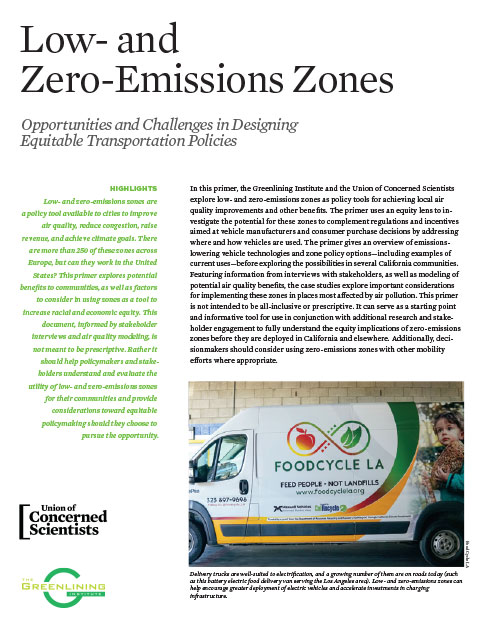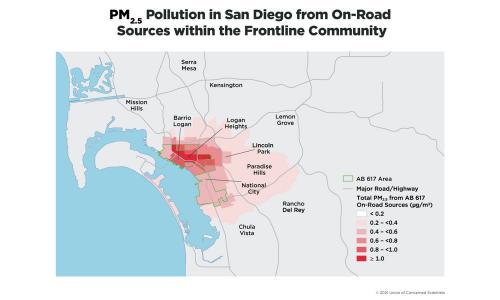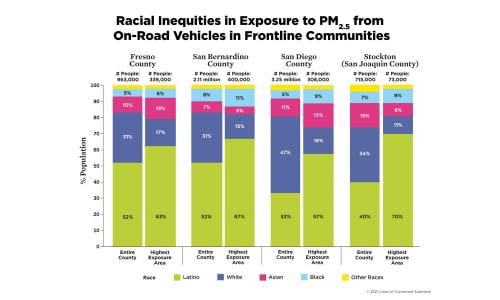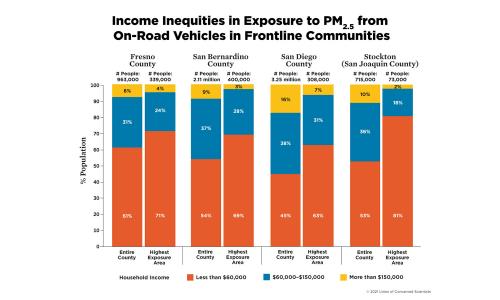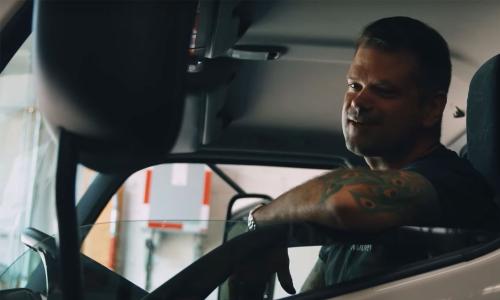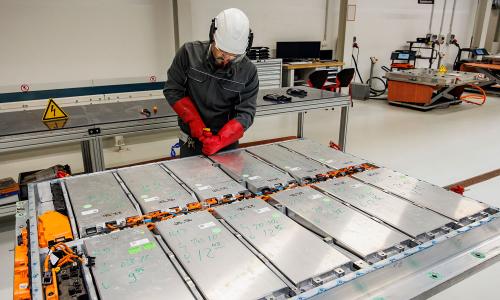Low- and zero-emissions zones are a policy tool available to cities to improve air quality, reduce congestion, raise revenue, and achieve climate goals.
There are more than 250 of these zones across Europe, but can they work in the United States? This primer explores potential benefits to communities, as well as factors to consider in using zones as a tool to increase racial and economic equity. This document, informed by stakeholder interviews and air quality modeling, is not meant to be prescriptive. Rather it should help policymakers and stakeholders understand and evaluate the utility of low- and zero-emissions zones for their communities and provide considerations toward equitable policymaking should they choose to pursue the opportunity.
Low- and Zero-Emissions Zones
This is a condensed, online version of the report. Access to all figures and full report are available through download of the PDF.
In this primer, the Greenlining Institute and the Union of Concerned Scientists explore low- and zero-emissions zones as policy tools for achieving local air quality improvements and other benefits. The primer uses an equity lens to investigate the potential for these zones to complement regulations and incentives aimed at vehicle manufacturers and consumer purchase decisions by addressing where and how vehicles are used. The primer gives an overview of emissions-lowering vehicle technologies and zone policy options—including examples of current uses—before exploring the possibilities in several California communities. Featuring information from interviews with stakeholders, as well as modeling of potential air quality benefits, the case studies explore important considerations for implementing these zones in places most affected by air pollution. This primer is not intended to be all-inclusive or prescriptive. It can serve as a starting point and informative tool for use in conjunction with additional research and stakeholder engagement to fully understand the equity implications of zero-emissions zones before they are deployed in California and elsewhere. Additionally, decisionmakers should consider using zero-emissions zones with other mobility efforts where appropriate.
Zero-Emissions Vehicle Technologies
Zero-emissions vehicles (ZEVs) eliminate tailpipe emissions by replacing a gasoline or diesel engine with an electric motor. Removing the tailpipe exhaust results in zero carbon dioxide (CO2) emissions from the vehicle and significantly reduces air pollution.
There are two types of ZEVs currently available: fuelcell electric vehicles and plug-in electric vehicles. Hydrogen fuel-cell electric vehicles use hydrogen and a fuel cell to store energy and deliver electricity to the motor. These hydrogen fuel-cell ZEVs are less common, in large part due to the relative lack of hydrogen refueling stations (compared to plug-in vehicle infrastructure) and higher technology costs.
Currently, most ZEVs are plug-in electric vehicles, storing electricity in a battery pack to power the electric motor. Plug-in vehicles come in two types: plug-in hybrid electric vehicles and battery electric vehicles. Plug-in hybrid electric vehicles have both a gasoline engine and battery pack (or electric motor system). A plug-in hybrid electric vehicle can operate solely on electric power when there is sufficient charge in the battery pack; the combustion engine is used when the battery pack is depleted. Thus, a plug-in hybrid electric vehicle is not a true ZEV. Battery electric vehicles do not have an engine, only an electric motor, and therefore always operate as a ZEV. However, plug-in hybrid electric vehicles could still be useful in the context of a zero-emissions zone (ZEZ) that restricts use of vehicles with tailpipe emissions if they can be designed to use only the electric motor within the zone.
Over the past decade, the number of ZEV models available has greatly increased, with many more expected to become available by mid-decade. Much emphasis has been placed on developing zero-emissions passenger car and truck models, but larger ZEVs are also becoming available, especially medium-duty trucks (such as delivery trucks) and buses (O’Dea 2020). While it may take more time for ZEV models to replace the largest trucks, there are now options to electrify the vast majority of vehicles, including buses and other public transportation options. Some cities already use electric transit and school buses to shuttle passengers without any tailpipe emissions, and many more are committed to electrifying their fleets.
In addition to buses, cars, and trucks, other zero-emissions transportation options are available. Bikes are familiar zero-emissions transportation, and now electric-assist bikes increase the distance people can bike and allow them to carry or tow cargo. Electric scooters are becoming more common in cities and allow them to more easily carry or tow cargo.
Over the past 10 years, the options for zero-emissions mobility and goods movement have expanded. With these technologies—such as electric buses, cars, trucks, bikes, and scooters—there are sufficient options to eliminate the vast number of polluting vehicles on roads. ZEZs are a means to encourage and enforce the deployment of these ZEV technologies and to support the broader transition from gasoline and diesel to cleaner sources of energy for transportation systems.
ZEZ Policy Options
In general, zoning is a policy option that cities and municipalities can implement on their own, although some types of zones need enabling legislation from the state to go into effect. A few types of zones can be created to meet the needs of a particular area. All zones should be tailored to meet the specific needs of the area and must be developed with stakeholder input to be effective (Pickford et al. 2017). Because these zones will directly affect stakeholders and cities risk losing support if they are designed poorly, the input process must go beyond a “check the box” approach. Stakeholder input must be genuine, robust, and in full acknowledgment of past instances in which stakeholder input was collected using the lowest standards.
A congestion zone zone is designed primarily to reduce vehicle travel and is often used to combat traffic and other issues caused by having many vehicles on the road. A low-emissions zone (LEZ) and a ZEZ are designed primarily to reduce emissions and are often used to combat air pollution and meet global warming pollution reduction goals.
Depending on how they are designed, congestion zones and LEZs or ZEZs can end up being substantially similar to each other, but there are important differences (see the table). In California, a city has the ability to implement a congestion zone on its own, but enabling legislation may be needed before cities can begin creating LEZs or ZEZs.
A congestion zone may limit vehicle entry by type or time of day. Often, a fee will be used to incentivize drivers to choose an alternative form of transportation within the zone or to avoid it altogether.
LEZs and ZEZs usually require vehicles to meet a certain pollution standard, but they can also be designed to apply only to certain classes of vehicles, such as heavy-duty trucks.
Both types of zones must be developed with stakeholder input and should reflect the realities of the local area to be effective. As covered in a later section, a full equity design of these zones must be considered to mitigate burdens on already affected communities and to maximize the benefits to those same communities. Failing to consider equity in the design of a ZEZ will only exacerbate negative impacts. Stakeholders can help inform the program goals, zone boundaries, necessary exemptions, enforcement mechanism(s), timing, and information transfer, among other characteristics. These zones are often controversial. Those that are most successful start with public communication as early as possible and continue through all stages of the project, including design, execution, and ongoing management (Pickford et al. 2017).
Examples across the World
Worldwide, various kinds of zones with different goals are taking shape. Europe leads the world in LEZs, with more than 250. In South America, Santiago, Chile, has undertaken establishment of the first such zone on the continent with its Zona Verde para el Transporte en Santiago. Singapore’s road pricing system was one of the first and has been in operation since 1975.
This section explores three case studies of cities with different types of zones: Santa Monica, California; London; and Paris.
SANTA MONICA Closest to home, there is a voluntary zero-emissions delivery zone in Santa Monica being piloted by the Los Angeles Cleantech Incubator through the Transportation Electrification Partnership (TEP). A public-private partnership, the TEP aims to accelerate Los Angeles’s transition to a zero-emissions transportation system in advance of the city hosting the 2028 Olympic games. The TEP solicited project proposals from communities in the Los Angeles area and selected Santa Monica in part due to the resources the city could bring to the pilot; these included municipal staff and representatives able to invest in the project, existing infrastructure, and a willingness to try new ideas. For underserved communities facing air pollution problems, resourcing this kind of project will be a challenge, and funding sources will be critical.
The zone project seeks to explore solutions and spur innovation. Its goals are to lower air pollution, congestion, global warming emissions, and noise, and to increase safety. Moreover, the TEP intends for the pilot to help provide a possible blueprint for cities, learning for delivery companies, and economic opportunities for small businesses and individuals.
The zone is small, covering one square mile, but it covers an area with extremely high traffic density. A mix of education, incentives, and new technology is employed to convince businesses and other entities to make the switch. Delivery vehicles of all sizes are targeted, from modes of restaurant delivery (including bikes, sidewalk robots, and electric scooters) to the biggest trucks stocking stores in the district. While the zone initially received funding for one year of operation, its organizers are seeking additional support for future years.
Because the zone is voluntary, no enforcement mechanism exists; however, there are benefits available to those who decide to comply with the zone guidelines. The city of Santa Monica has prioritized curb space for zero-emissions delivery vehicles, for example, while the state has provided money to subsidize participation in the zone. Some companies have made in-kind donations of compliant vehicles, which can be accessed by participating entities. Innovations include an app that local businesses can use to schedule deliveries on a shared electric truck, new curb monitoring technology that allows the city to warn vehicles that do not comply with the standard, and sidewalk delivery robots that can bring food to beachgoers and residents without going in the street at all. The curb monitoring technology should also allow the city to understand more about congestion levels, curb availability, and idling times for vehicles in the zone.
As a small-scale pilot project, the zone faces the not insignificant challenge of tracking results without a compliance mechanism. Further, because the pilot project began during the COVID-19 pandemic, comparisons to a historical baseline may not reflect the zone’s effects solely. However, companies that agree to use ZEVs within the zone can track their miles to estimate the reduction in tailpipe emissions, and some air quality data can be extrapolated from that. In all, however, the effects of this zone will likely focus more on learning what cities need to make LEZs work and innovating creative solutions, rather than on direct pollution or traffic reduction.
LONDON Across the pond, London operates one of the biggest and most ambitious zoning schemes in the world. London actually has three different zones: a congestion zone, an ultra-low-emissions zone (ULEZ), and an LEZ (Transport for London, n.d.).
Inspired mostly by traffic problems in London, the Congestion Charge—a toll on vehicles operating within a zone of eight square miles—has been in operation since 2002. Over the years, two other zones meant to reduce health impacts from air pollution have been created, and their stringency, along with the projected benefits, will continue to ramp up in the future.
The Congestion Charge applies in Central London to all vehicles from 7:00 a.m. to 10:00 p.m. every day, except Christmas. The ULEZ applies in Central London to all vehicles at all times, except Christmas. The LEZ applies in most of Greater London to medium- and heavy-duty vehicles at all times. The zones are additive, meaning a driver operating a noncomplying heavy-duty vehicle in Central London during business hours would pay three fees: the charges for the LEZ and ULEZ, and the Congestion Charge.
All the fees are significant enough to serve as a deterrent to noncompliance and carry additional penalties if not paid within a day or so. To drive in the congestion zone costs £15.00 per day, with additional penalties for paying late. The fee for operating a passenger car or medium-duty vehicle that does not meet the emissions standards in the ULEZ is £12.50 per day, while the same charge for a heavy-duty vehicle is £100.00 per day. In the Greater London–area LEZ, medium- duty vehicles are charged £100.00 per day if they do not meet Euro 3 particulate matter (PM) standards. Heavy-duty vehicles are charged £100.00 if the vehicle meets Euro 4 or 5 standards, and £300.00 if they are below Euro 4.
There are no exemptions to the fee based on income; however, other exemptions do exist. During a transitional period, vehicles that meet ultra-low-emissions standards will be allowed in the Congestion Charge zone for free. From 2021 to 2025, only battery electric vehicles will be exempt from paying the fee, and after 2025, no vehicles will be exempt based on their emissions. Residents of the zone who obtained the 100 percent ULEZ discount may continue to use it through October 2021, after which their vehicles must meet the emissions standards or be subject to the fee. Certain vehicles designated for use by disabled persons are exempt. Taxis are also exempt, as they are governed by other rules limiting their lifetime on the road. Buses and other high-capacity transportation are exempt, as are motorbikes, and—during the current COVID-19 pandemic—vehicles of National Health Service employees.
There is street signage when entering the zone, but no barriers or booths. Enforcement is done by cameras that take photos of license plates, which are matched against a registration database (the Automatic Number Plate Recognition system). Fees are due within three business days, but they can be paid in advance of operation in the zone or by autopay if the vehicle is registered in the system.
There is street signage when entering the zone, but no barriers or booths. Enforcement is done by cameras that take photos of license plates, which are matched against a registration database (the Automatic Number Plate Recognition system). Fees are due within three business days, but they can be paid in advance of operation in the zone or by autopay if the vehicle is registered in the system.
The city reinvests money raised from the program into public transportation, as well as other transportation-related improvements. The Congestion Charge alone raises £150 million per year for these purposes, and despite the city’s population increasing by 20 percent, congestion levels remain similar to 2002 levels (C40 2019a).
The first mayor of London, Ken Livingstone, played a key role in leading the creation of the original Congestion Charge as it was a key plank in his inaugural election run platform in 2000. Within two years of his election, the charging zone was up and running. The idea was never brought up for a public vote as proposed by its opponents, which could have delayed the project for years. Instead, the mayor was flexible, willing to negotiate, and made concessions, such as the inclusion of transitional periods and resident discounts, which helped build public support.
The city undertook an extensive public consultation process, employing general marketing and education campaigns, as well as specific stakeholder outreach and two-way conversation opportunities through roundtables, public meetings, email, phone, mail, and public postings and exhibitions. Members of the media were educated about the policy, and the agency responsible actively monitored and followed up about coverage to ensure accuracy. While on the launch of the zone, only a slim majority of residents supported it, a year later, support had risen to 75 percent (BBC 2004). Mayor Livingstone won reelection against a challenger whose platform included scrapping the zone.
Congestion charging in the zone is directly responsible for reductions of almost 10 percent of nitrogen oxides (NOx) and PM10 emissions, and more than 16 percent of CO2 emissions (C40 2019b). More recently, the ULEZ was found to have reduced nitrogen dioxide by more than a third in the first six months of its operation (Greater London Authority 2019).
A 2020 report from the mayor of London’s office on the effects of the ULEZ found significant air quality improvements since the zone’s introduction in 2016. In those four years, the number of state primary and secondary schools in areas exceeding legal limits for NO2 [nitrogen dioxide] fell from 455 in 2016 to 14 in 2019, a reduction of 97 per cent. For the first time, parts of London meet the World Health Organization (WHO) recommended limit for PM2.5 [fine particulate matter]. Since February 2017 there has been a 44 per cent reduction in roadside NO2 in the central London ULEZ, with 44,100 fewer polluting cars being driven in the zone daily. CO2 emissions in the central zone are estimated to have reduced by 12,300 tonnes, a reduction of 6 per cent because of the ULEZ. (Greater London Authority 2020)
The zones have encouraged a mode shift in London; fewer trips are being made in cars and more trips feature active transportation (like walking or cycling) or public transportation since the first congestion zone was introduced (C40 2019a). London’s goal is for 80 percent of trips to be taken by active or public transportation by 2041, up from 65 percent today.
PARIS
Paris also has zones to reduce air pollution impacts on public health, but the city uses a different enforcement mechanism than London.
The Central Paris Zone à Circulation Restreinte was created first, and the Greater Paris Zone à Circulation Restreinte is being independently and voluntarily adopted by all municipalities in Greater Paris. By 2021, it is expected that 100 percent of the municipalities will have adopted the program, and both zones will have the same rules.
While the zones are operational (Monday to Friday from 8:00 a.m. to 8:00 p.m.), only vehicles that meet the emissions standards are allowed to enter. As with the London zones, the stringency requirements will increase until 2030, when only battery electric and hydrogen fuel-cell vehicles will be allowed in the zones. The majority of both of these zones fall in the jurisdiction of the Paris zone de protection de l’air, which can ratchet up standards temporarily during times of dangerously high pollution.
Unlike London’s use of cameras and the Automatic Number Plate Recognition system, Paris’s enforcement happens through visual inspection by police. Drivers are required to purchase a Crit’Air sticker, which denotes which emissions standards the vehicle meets. The police may stop and cite anyone in violation of the posted standards for the zone. Fees range from €68.00 for cars and motorbikes to €135.00 for trucks.
The effects of the Paris LEZs are not yet known, but analysis by the International Council on Clean Transportation “projects that with the implementation of the more stringent entrance requirements for access to the LEZ, passenger car NOx emissions in 2024 will be 76% to 87% below 2016 levels. In contrast, without the LEZ Paris would likely not see similar reductions in vehicle NOx emissions until 2031–2034, and in 2024 average passenger car NOx emission factors would be only 47% to 62% below 2016 levels.” The analysis also recommends moving to automated enforcement mechanisms for more effective emissions reductions (Bernard et al. 2020).
It is important to remember that the cities of Europe that have begun implementing LEZs have some major differences from most US cities. First, the European cities tend to be much denser. Larger populations provide much larger tax bases on which to pull for common services, including the operation of a congestion or low-emissions zoning program. Second, public transportation in Europe is more developed, and generally, the public is less car dependent than the US population.
Thus, tweaks would be necessary to introduce these zones in the United States. To implement a zone successfully, it must be tailored to the needs of the residents and must not cause more harm than good. A zone that applies only to heavy-duty vehicles, for example, could work better to reduce air pollution than one targeting all vehicles in a location where most residents are car dependent and public transportation does not meet the mobility needs of the population.
Making Equity Real in ZEZs
With so many examples of existing ZEZs to learn from, it is crucial that in collecting information and attempting to replicate a similar policy in California, equity is front and center in any ZEZ conception. The Greenlining Institute defines “racial equity” as “transforming the behaviors, institutions, and systems that disproportionately harm people of color. Equity means increasing access to power, redistributing and providing additional resources, and eliminating barriers to opportunity, in order to empower low-income communities of color to thrive and reach full potential” (Mohnot, Bishop, and Sanchez 2019).
Fresno, San Diego, San Bernardino, and Stockton (which are all disadvantaged communities with funding to create community-led air quality mitigation plans under California’s Assembly Bill 617, or AB 617) serve as case study cities through which we assess the potential for equitable ZEZ development.* Disadvantaged communities that fall under AB 617 are defined by Section 39711 of California Senate Bill 535 as those identified based on geographic, socioeconomic, public health, and environmental hazard criteria, and may include, but are not limited to, either of the following:
(a) Areas disproportionately affected by environmental pollution and other hazards that can lead to negative public health effects, exposure, or environmental degradation.
(b) Areas with concentrations of people that are of low income, high unemployment, low levels of homeownership, high rent burden, sensitive populations, or low levels of educational attainment.” (AB 617 2017)
We use the Greenlining Institute’s Making Equity Real guidebook as a framework to assess equity considerations in ZEZs and their potential benefits to these frontline communities. The guidebook establishes that equity can and should be accomplished through a four-step process, embedding and ensuring equity in
- the mission, vision, and values of the zones;
- the stakeholder process itself;
- clearly articulated outcomes; and
- measures and analyses of equity efficacy.
We conducted interviews with key stakeholders in Fresno, the Inland Empire, San Diego, South Coast, and Stockton to inform our equity approach and understanding of community needs. Examples of established ZEZs are predominantly found in European countries where factors such as income, race, fuel type, transit options, and regulatory processes create a context that is not transferable to the United States. Thus, this primer gathers information from both current ZEZ literature and key stakeholder interviews to consider California’s context in the design of an equitable ZEZ. The following section highlights five key equity concerns we raise as a result of our literature review on existing ZEZs.
Equity Concerns about Existing ZEZs
General lack of information and education on ZEZs. In the literature, there are limited available ZEZ education materials that are accessible and targeted to a lay audience. Education and outreach constitute key parts of a dissemination strategy for any policy and play a key role in equitable information distribution. Given that ZEZs are novel to the United States, awareness of this potential transportation policy and its workings is limited. Should ZEZs be considered, investment in education, marketing, and outreach— particularly in communities that will be directly affected by a ZEZ—must be present.
Ability to pay fees, fines, and penalties for personal or business internal combustion engine vehicles. Populations residing in communities affected worst by poverty and pollution are overwhelmingly Black and Latino. This demographic overrepresentation directly results from policies culpable of inhibiting upward mobility because of income inequality and the growing racial wealth gap disproportionately affecting people of color. Historic and current income inequality is now compounded by a pandemic-induced recession. Therefore, the fee structure of a ZEZ must avoid regressive charges and consider low-income individuals’ ability to pay. Fee structures in the design of ZEZs should include incentives, programmatic discounts, and subsidies to reduce costs for those who are less financially secure. A tiered fee structure designed with income equity in mind would limit penalties on low-income residents who otherwise would be burdened with additional transportation barriers impeding both physical and economic mobility.
Focus on greatest pollution sources: medium- and heavy-duty vehicle impacts on disadvantaged communities. On June 25, 2020, in a unanimous decision, the California Air Resources Board approved the Advanced Clean Truck rule, a first-of-its-kind regulation mandating that manufacturers increase sales of electric trucks and vans beginning in 2024 to achieve 100 percent zero-emissions sales of medium- and heavy-duty vehicles by 2045 (CARB 2020). The rule requires that 75 percent of local delivery trucks reach zero emissions even sooner, by 2035, to combat emissions from deliveries—pollution that is especially harmful and increasing in volume during this global pandemic. Considering equity, decisionmakers should analyze the potential impact a dedicated freight-focused ZEZ could play in the acceleration of pollution reduction goals set by regulations such as the Advanced Clean Truck rule, as they eliminate the burden on personal use vehicles (Aguayo 2020).
Disadvantaged communities have historically borne the brunt of freight and goods movement pollution. A freight-focused ZEZ could therefore be implemented where the greatest amount of truck deployment currently exists to reduce the most pollution. Should a freight-specific ZEZ be considered, subsidies dedicated to small and low-income fleets must be included to make the transition to zero- emissions trucks equitable.
Potential harmful impacts on low-income communities and communities of color. According to our literature review of existing ZEZs, most enforcement mechanisms rely on fines and surveillance technology to implement the zone. Historically in the United States, low-income individuals and people of color have been overpoliced and hypersurveilled, with transportation violations serving as one of the pretenses for disparate citations—citations that often lead to abuse of power, criminalization, and death. In considering a ZEZ, as with any transportation policy, decisionmakers should conduct an impact study of enforcement practices and their effects on marginalized communities. At a time when trust in police and state authority is increasingly fraught, implementation and enforcement measures for ZEZs must exclude oppressive practices.
Equitable use of revenue generation from ZEZs. Should fines be levied from enforcement of ZEZs, the revenue generated should be applied to equitable projects that prioritize the mobility needs of communities burdened by pollution and barriers to accessible, safe, and sustainable transportation. Examples of projects include subsidized public transit, sidewalk repairs, and bike lane installations. Regardless of the kind of transit or capital improvement, participatory budgeting (the process by which community members decide how public funds are spent) must be central to the decision-making process for revenue use.
ZEZ Perspectives from Community Stakeholder Interviews
The Greenlining Institute gathered qualitative information from various stakeholders working on air pollution mitigation efforts in communities located in East Los Angeles, Fresno, the Inland Empire, San Diego, and Stockton. After a series of interviews, we determined that the following six points were consistent, insightful, and critical to consider in the development of any ZEZ:
WILL IT BE BURDENSOME?
The most significant stakeholder concern was the risk of burden that would fall on residents of disadvantaged communities as a result of a ZEZ. Topics under this umbrella included the following:
- The displacement of PM2.5 to peripheral areas—that is, that polluting vehicles unable or unwilling to comply with a ZEZ would find alternate routes around the zone and increase pollution in surrounding communities;
- Limited access to enter and exit the zone due to an inability to afford an electric vehicle; and
- Competition for funding and deprioritization of other major community needs, such as affordable housing, food desert mitigation, and public infrastructure—especially in the context of limited resources and a legacy of disinvestment. One stakeholder noted, “No matter what care you have, you still need to ensure you get your basic needs met.”
ENFORCEMENT AND ACCOUNTABILITY CONCERNS
Like the authors, who had initial concerns after assessing the literature review, stakeholders expressed uneasiness about both enforcement and accountability in the establishment of a ZEZ. Stakeholders raised enforcement qualms related to increased surveillance and disparate punitive measures to implement a ZEZ. Additionally, they noted reservations about the efficacy of accountability provisions to ensure polluters actually adhere to a ZEZ. To decide which enforcement and accountability measures will make the most sense and produce the least amount of harm, community voices must be central to the conversation and the decisionmaking process.
FUNDING AND LOCAL POITICS
A consistent issue raised among stakeholders involved the obstacles posed by local politics and governance structures, which often impede or delay distribution of public and grant funds to recipients in the most affected communities. A stakeholder noted, “A big challenge right now is just getting residents their stipends from . . . grants.” In one interview, it was reported that the City of Fresno was misusing funds for farm tilling and avoiding open air burning, rather than for the intended transportation-related air pollution mitigation. An interviewee stated, “Across California, the commonalities [in the sources of air pollution] are freight, oil, gas, ports, etc., that are the issue, but [the decisions and processes to improve air quality are] still up to the cities and land use [policy]. There is lack of state authority at the local level.”
Governance and local politics present specific challenges to establishing a ZEZ, including mishandling of public funds, poor communication, misalignment among state and local leaders, and a lack of community trust. In another interview with representatives of an organization located in the Inland Empire, concerns regarding tension between air districts (regional air quality management agencies) and the California Air Resources Board were raised as an example of how state and local powers are not coordinated. Questions regarding what governing body would intervene surfaced repeatedly from interviewed stakeholders. Based on feedback, alignment across jurisdictions and communication across agencies are critical to ensure pollution reduction goals. One stakeholder noted, “Zero-emission zones are definitely a need that should be part of the conversation . . . but the challenge is developers who are pro-economy [and ignore] the issue.”
In addition to acknowledging existing hurdles, it is necessary to recognize the historic mistrust low-income residents and residents of color have had of local governments, which have commonly deprioritized relationship-building. An interviewee said, “There is a nihilistic and defeatist culture from a historically colonized people, and the sense is that will continue to happen. There may not be opposition but also no support.”
DISTRIBUTION OF BENEFITS AND ASSET STACKING
A central question asked by stakeholders regarding ZEZ design was, how would the benefits of a ZEZ be distributed so that the most affected communities are first in line?
The implementation of the policy or grant program must lead to equity outcomes that respond to community needs, reduce climate vulnerabilities, and increase community resilience. Outcomes can include improved public health and safety, workforce and economic development, clean vehicle subsidies, and alternative transportation options.
However, no transportation policy works in a vacuum, independent from other policies, political climates, or social progress. A key recommendation for implementing an equitable and successful ZEZ is to pair the policy with other emissions-reduction strategies, investments in improved air quality and transportation, and effective land use that promotes healthy places to live, work, and play. Ideally, as equity benchmarks are achieved, the goalpost should keep moving as ambitiously as possible.
A SECTOR- OR GEOGRAPHY-BASED APPROACH OR ALTERNATIVE
In conversations with a stakeholder embedded in emissions-reduction practices in the communities most affected by poverty and pollution, the interviewee asked whether policymakers’ interest in implementing a ZEZ should be “looking at transportation emission reductions specifically . . . [or] more broadly a low-emission zone mitigating all pollution sources in the area?” This question posits if ZEZs could be designed to mitigate emissions beyond just transportation-specific polluting sources and implemented in large territories. If so, ZEZs could be designed to address pollution from a specific vehicle type or from nontransportation-related emissions, or implemented in smaller, more acutely polluted zones.
As a result of this question, we encourage policymakers to consider ZEZs that could be targeted at reducing exclusively transportation-related emissions from one or all of the following: heavy-duty diesel trucks and buses (as mentioned above), port emissions from cargo and commercial ships, off-road equipment, aircraft, locomotives, passenger vehicles, and light-duty trucks.
Alternatively, ZEZs could be designed to reduce pollution from large stationary facilities, manufacturing and industry, residential fuel consumption, and agriculture. The benefit of a narrowly focused ZEZ is the ability to target a very specific emissions source that may be more appropriate for certain communities. Where some residents may find that port-related emissions are more pertinent than trucks and buses, others may find that agriculture-related emissions and pesticide pollution are a greater concern. This was an interesting finding and a question that should be considered on a case-by-case basis, as different areas are affected by different pollution sources.
In addition to considering sector-based and pollution-type design approaches to ZEZs, decisionmakers could weigh geography-centered design approaches. Rather than implementing a broader ZEZ similar to examples in Europe, which encompass the majority of a city center or downtown area, creating a ZEZ that is smaller in scale but located at a critical and extremely polluting location (such as a port, highway intersection, warehouse depot, or school) may be a better solution.
FUNDING OVERSIGHT
Funding dissemination for disadvantaged community projects has been a challenge for many grant recipients. When we conducted our interviews in the summer of 2020, the majority of stakeholders noted that community engagement compensation stipends were being delayed. According to one interviewee, “there is a fight to get folks [stipends] to participate in engagement, and the air districts have the money but don’t want to distribute.” These delays spawned further mistrust among the community and led to even less support for projects.
Funding oversight is particularly key to the success of a potential ZEZ, because if a ZEZ is designed to generate revenue from fines levied on polluting vehicles and earning oversight is mismanaged, community relations may be further strained and opposition is more likely. As one stakeholder put it, “So there is a concern about creating another pot of funding and giving it to the air district. . . . There are structural issues and the [community] would most likely want [funds] to go to another place . . . to make sure it’s in community hands.”
In the case of Stockton, one stakeholder indicated that proponents “may receive support from Mayor [Michael] Tubbs for a policy like this, but [Stockton] is a strong city manager type city . . . reliant on fiscal responsibility measures, especially after the town declared bankruptcy.” In other words, funding oversight is crucial not only for buy-in from the community but for a ZEZ’s sustainability.
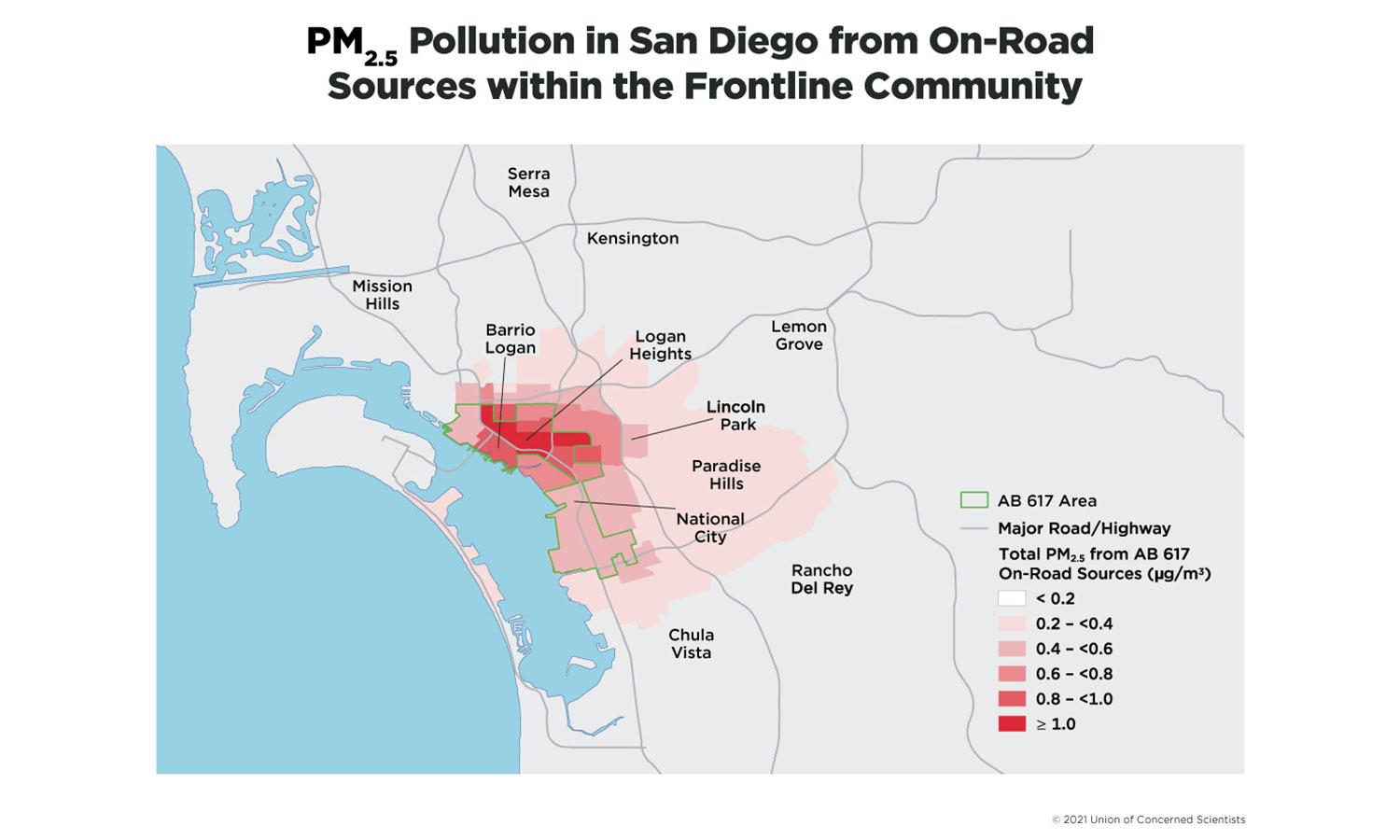
LEZ and ZEZ Potential Benefits and Current Population Burdens
One of the major potential benefits of an LEZ is improved air quality. This section of the primer investigates the potential air quality benefits of ZEZs in several of the AB 617 communities where stakeholder interviews were also conducted.
Air pollution generated from on-road vehicles harms people. Some of this pollution comes from the direct emissions of compounds such as PM2.5 and ozone, but other vehicle emissions, such as nitrogen oxides and gasoline vapors, react in the atmosphere to create further harmful PM2.5 pollution.
Exposure to PM2.5 pollution has been shown to shorten lives, and higher levels of PM2.5 in the air are linked to many ailments, including asthma, cardiovascular disease, and stroke (Brook et al. 2010; Fine, Sioutas, and Solomon 2008). California has PM2.5 pollution levels significantly higher than the national average, and on-road sources constitute a major source of this air pollution. PM2.5 pollution from buses, cars, and trucks is particularly high in the Central Valley and urban Southern California (Reichmuth 2019).
Not only are the levels high in those regions, the exposure to PM2.5 is inequitable with respect to race (and income to a lesser degree). Black Californians are exposed to PM2.5 pollution that is 43 percent higher, on average, than that for White Californians, and Latino community members are exposed to PM2.5 pollution 39 percent higher, on average, than that for White Californians. The lowest-income households in the state live where PM2.5 pollution is 10 percent higher than the state average, while those with the highest incomes live where PM2.5 pollution is 13 percent below the state average (Reichmuth 2019).
ZEZs have the potential to eliminate tailpipe emissions in a targeted area. By replacing combustion engines with electric motors, the vast majority of emissions that lead to PM2.5 pollution can be eliminated. To illustrate the potential for a ZEZ to reduce pollution exposure, we estimated current vehicle emissions in four California cities that have areas designated as most affected by air pollution (by the AB 617 Community Air Protection Program). We examined communities within Fresno, San Bernardino, San Diego, and Stockton to estimate the reduction in PM2.5 pollution exposure that could be achieved by eliminating tailpipe pollution within the community boundaries. While a complete ZEZ throughout a community may not be possible today, this analysis gives a sense of the possible change in emissions and equity impacts of ZEZ policies.
The results show that a targeted policy to reduce tailpipe emissions, such as a ZEZ, could reduce pollution exposure both within the zone and in adjacent areas. If these zones are placed within communities of color that currently have high exposure to air pollution, such as AB 617 communities, the zones have the potential to start to reduce inequities in pollution burden between racial and economic groups.
For example, PM2.5 pollution from on-road vehicles in the San Diego frontline community has the most impact on neighborhoods that are less White and have more lower-income households than on the county overall (Figure 1). San Diego County is 47 percent White, but the population affected by on-road pollution coming from the AB 617 area is only 16 percent White (Figure 2, p. 14). Similarly, 45 percent of households in San Diego County have an annual income of less than $60,000, while in the areas most affected by air pollution from vehicles in the AB 617 area, 63 percent of households make less than $60,000 per year (Figure 3, p. 15).
Reducing sources of PM2.5 pollution in an AB 617 area would likely benefit lower-income households and Black and Latino people in the cities studied. While this analysis looks at the complete removal of on-road tailpipe PM2.5 pollution, a partial removal of tailpipe pollution using a ZEZ for larger trucks should show similar equity results.
In addition to a reduction in tailpipe pollution, ZEZs could have other benefits for communities. Restricting traffic to ZEVs could reduce noise, especially if larger diesel trucks and buses are excluded from travel within the zone. ZEZ implementation could also result in the elimination or relocation of gasoline and diesel refueling stations, and in reduced local pollution, including groundwater contamination.
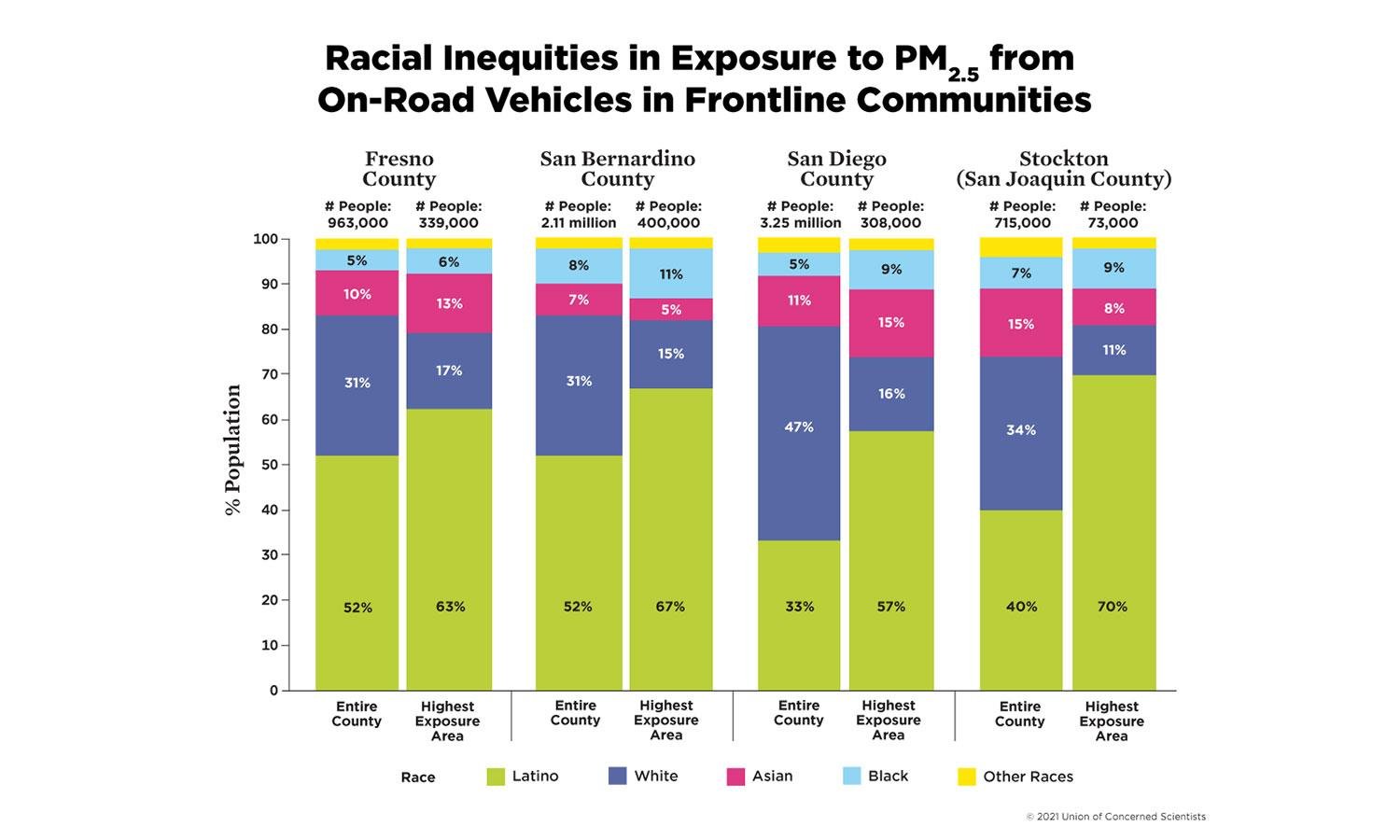
Policy Recommendations
Local entities interested in LEZs can pilot voluntary zones, such as the one in Santa Monica, but they cannot enforce zones without enabling state legislation. California should allow LEZs to be developed by cities, and it should encourage the development of zones with proper public oversight and stakeholder engagement. Furthermore, the state can provide technical assistance, funding, and measurement, evaluation, and learning resources to make the most of pilot projects, especially in under-resourced communities.
If pilots get under way, local entities will need to be sure to communicate early and often with their stakeholders, including vulnerable communities and affected businesses. Comprehensive feasibility and risk assessments should be conducted and the results communicated, and at all stages of design, implementation, management, and operation, public feedback should be sought and incorporated to ensure success.
Especially when considering these zones in communities of color, enforcement mechanisms must not perpetuate systems of oppression. It is not recommended that police enforce the zone, and fines must not further harm the most economically disadvantaged individuals. Community stakeholders must be at the table to decide what enforcement mechanisms—such as automatic license plate readers—may be appropriate.
State and local resources and incentives should be coordinated to maximize a zone’s benefits or mitigate potential harm. For example, the incentive to scrap and replace the most polluting vehicles could be increased in areas where an LEZ would make it more expensive to drive that vehicle.
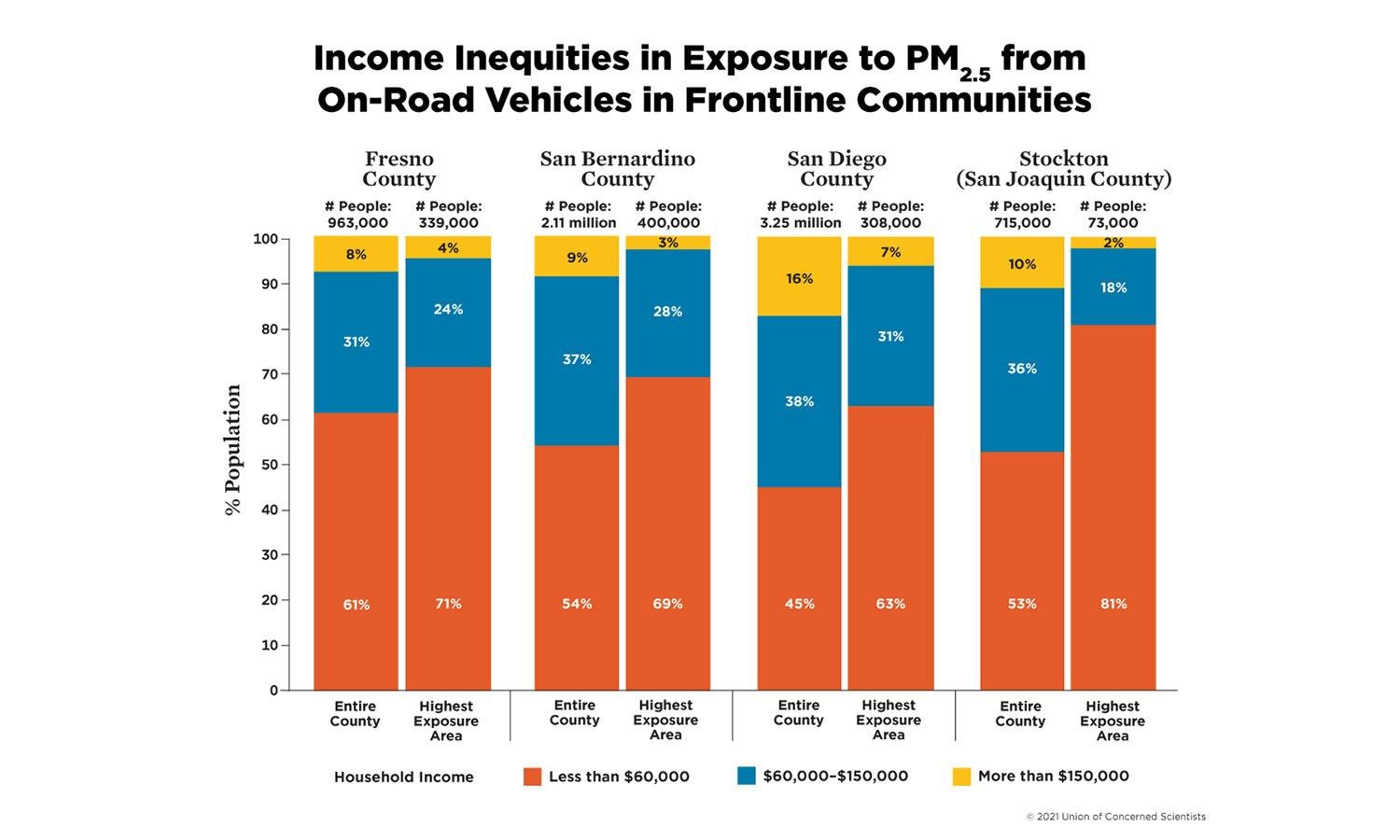
Conclusions
Communities in other countries have established ZEZs to discourage the use of polluting gasoline and diesel vehicles in dense urban areas. Given the high levels of vehicular air pollution in California and the racial inequities in exposure to tailpipe pollution, communities in the state may want to explore ZEZs for passenger and freight vehicles. ZEZs are promising because in addition to promoting long-term change, such as fleet turnover, if designed equitably, they can direct the benefits of existing clean vehicle policies to people who are overburdened by harmful air pollution.
In implementing ZEZs in disadvantaged communities, there are important equity considerations that must be addressed, such as access to cleaner vehicles and chargers, potential failure of market-based approaches, and, most importantly, assurance that the community potentially affected has the power to determine the structure and implementation of the zone.
Similarly, decisionmakers must consider many factors in pursuing an LEZ, and each city will need to explore the options that work locally. For too long, in implementing solutions to help the environment, decisionmakers have missed the opportunity to create economic and racial justice. ZEZs hold potential to further all three, but the policy should be considered carefully within each local context.
About the authors Leslie Aguayo is the Climate Equity Program manager at The Greenlining Institute. Coreen Weintraub is the Western States campaign manager at UCS. David Reichmuth is a senior engineer in the UCS Clean Transportation Program.
ACKNOWLEDGMENTS
This primer was made possible by the generous support of the Energy Foundation, the Heising-Simons Foundation, the William and Flora Hewlett Foundation, and UCS members.
The authors would like to thank the following people for their thoughtful review of the report: Dillon Delvo, Little Manila Rising; Sandy Naranjo, Mothers Out Front; Cynthia Cortez, Southeast Los Angeles Collaborative; Neena Mohan, California Environmental Justice Alliance; Ivanka Saunders, Leadership Counsel for Justice and Accountability; Kelly Schmandt Ferguson and Shevonne Sua, Los Angeles Cleantech Incubator; Alvaro Sanchez and Bruce Mirken, The Greenlining Institute; and Jimmy O’Dea and Don Anair, Union of Concerned Scientists.
Organizational affiliations are listed for identification purposes only. The opinions expressed herein do not necessarily reflect those of the organizations that funded the work or the individuals who reviewed it. The Union of Concerned Scientists and The Greenlining Institute bear sole responsibility for the report’s contents.
This is a condensed, online version of the report. Access to all figures and full report are available through download of the PDF.
Downloads
Citation
Aguayo, Leslie, David Reichmuth, Coreen Weintraub. 2021. Low- and Zero-Emissions Zones. Cambridge, MA: Union of Concerned Scientists. https:/www.ucsusa.org/resources/low-and-zero-emissions-zones
